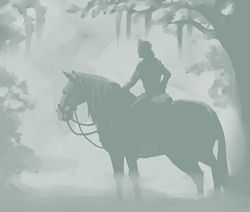|
|
The following list contains names of some of the Revolutionaries that Francis
Marion interacted with during his service.
| |
|
Major
General Horatio Gates
Marion and a small, ragged contingent of approximately twenty militia
offered their services to Major General Horatio Gates shortly before
the Battle of Camden. Marion was encamped with Gates for a short
while in July of 1780. Because of the appearance and demeanor of
Marion's men, however, Gates did not take them seriously and did
not feel they would be an asset in his coming battle with the British.
Gates instead ordered Marion and his men to go down the Santee and
burn anything the British could use for transport (39). He also
ordered Marion to take command of the Williamsburg militia. Gates
was later defeated at the Battle of Camden on August 16, 1780. If
Gates had not ordered Marion and his small band of followers away,
they may have been taken prisoners or killed at the Battle of Camden.
|
|
| |
Major General Nathaniel Greene
Greene was favored by George Washington; in fact, it was Washington
who suggested Greene be placed in command of the Continental Army.
Congress, however, had a different idea, instead choosing Major General
Horatio Gates (39). After severe disappointments in the command of
the Continental Army, Greene took control of the Continental troops
on December 3, 1780 (114-5). |
|
| |
Brigadier General William Moultrie
Marion served under Capt. Moultrie during the Cherokee War and at the
Battle of Fort Sullivan. At the onset of the Revolutionary War, the then
Captain Moultrie was made Colonel of the Second Regiment (11). For his
renowned defense of Fort Sullivan, Moultrie was greatly esteemed and the
fort was later renamed Fort Moultrie. He later became governor of South
Carolina. |
|
| |
Brigadier General Thomas Sumter
Sumter was elected by the Continental Congress to be the “Lieutenant
Colonel, Commandant, of the Second Regiment of Riflemen” in 1776
(15). On October 6, Sumter was appointed Brigadier General of Militia
by Governor Rutledge (73). He was considered the South Carolina’s
“Gamecock” by Lt. Colonel Tarleton because Sumter fought like
a gamecock. (82). Wounded by a rifle ball, Sumter fled Lt. Colonel Banastre
Tarleton. Tarleton pursued but could not locate Sumter; he just assumed
Sumter would die of the injuries he sustained (94). However, Sumter did
not die, and in February of 1781, he and Marion were supposed to meet
to attack Fort Watson; however, Sumter left without Marion when he learned
that Colonel Watson was “mobilizing forces at Fort Watson”
(142). |
|
Work Cited
Bass, Robert D. Swamp Fox: The Life and Campaigns of General Francis
Marion. 1959. Columbia: Sandlapper Press, 1972.
top

|
 |


